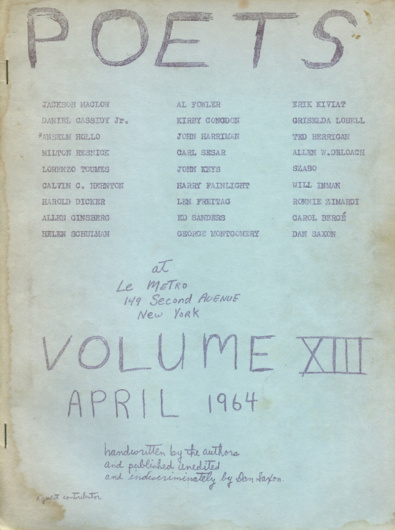Poems Collected at Les Deux Mégots/Poets at Le Metro
Dan Saxon
New York
Nos. 1–20 (December 1962–January 1965).
Poets at Le Metro 19 (December 1964).

During the 1950s, East Tenth Street between Third and Fourth Avenues housed a number of art galleries exhibiting the most advanced art in America on a street that until then had been occupied by pawnshops, pool rooms, and sheet metal shops. During that decade, the area became a primary stomping ground for the young Abstract Expressionist painters and their attendant theorists/promoters, Harold Rosenberg and Clement Greenberg. Here, also, poet Frank O’Hara served as an important link between artists and poets in the East Village. Art openings became mandatory for “networking,” and several of the galleries along Tenth Street also offered poetry readings and jazz. The Tenth Street Coffee House, owned by Micky Ruskin, was the scene from 1960 until 1962 of the first poetry readings in the area (organized by Chester Anderson, Howard Ant, and Ree Dragonette, and including Carol Bergé, Jackson Mac Low, and Diane Wakoski among the readers). Ruskin then moved his cafe and the readings to a larger basement storefront at 64 East Seventh Street, christened Les Deux Mégots Coffee House. The Monday and Wednesday night readings organized there by poet Paul Blackburn were transferred a year later, in February 1963, to Cafe Le Metro, owned by Moe and Cindy Margules (Ruskin went on to open Max’s Kansas City, a famous nightspot frequented by Andy Warhol and other stars of the downtown art and music scenes in the 1960s).

Poets at Le Metro 8 (April 1964).
At both Les Deux Mégots and Cafe Le Metro, poet Dan Saxon distributed Ditto masters to the readers, who would write directly on the stencils, and used a Ditto machine to produce a magazine that that he circulated for free. Among those who spoke or sang in the coffeehouses were Julian Beck of the Living Theatre, Ted Berrigan, Paul Blackburn, Allen Ginsberg, William S. Burroughs, Diane di Prima, Bob Dylan, Frank O’Hara, Gerard Malanga, LeRoi Jones, Denise Levertov, Charles Reznikoff, Lawrence Ferlinghetti, John Wieners, and Gregory Corso, most of whom also appeared in the pioneering mimeos produced by Saxon. In February 1964, Cafe Le Metro became the battleground for one of the most important First Amendment fights in New York City’s literary history. A city license inspector appeared at a reading by Jackson Mac Low and issued a summons, citing the New York Coffee House Law of 1962, which outlawed unlicensed “entertainment.” Enforcement of this law in such cases would have put the small neighborhood coffeehouses that did not serve liquor out of business, because cabaret licenses were expensive, and were accompanied by more stringent fire department codes and other regulations. The poetry community, led by Allen Ginsberg, Paul Blackburn, and Ted Berrigan, fought for and won the right to read poetry without a cabaret permit.
[Information adapted from Bill Morgan’s The Beat Generation in New York: A Walking Tour of Jack Kerouac’s City (San Francisco: City Lights, 1997).]
